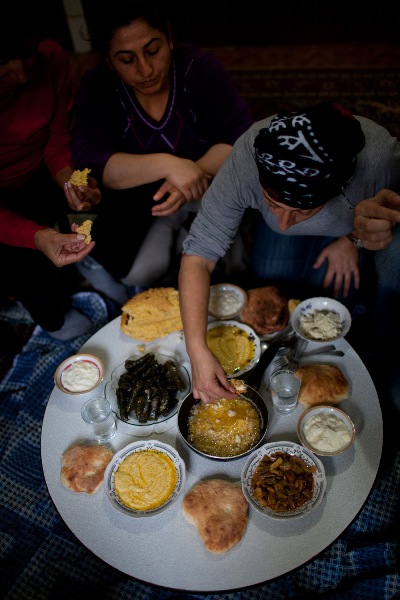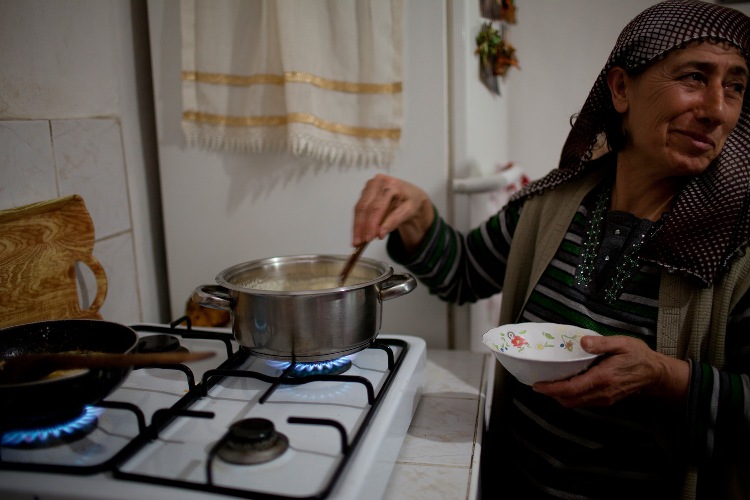**In the Marash dialect the Է as in “փէխէնդ” just as in many others the Է is pronounced like the A in “and” or the E in “bet”. A case to show why we have Է and Ե.
Halwa-Halawa-Helwa. The below "halaweh"is in the plural mode, as in the Armenian «անուշեղէնք». Just like the Arabic word "hurrieh/freedom" with the silent suffix T is interperted by some people as "hurrieT".
Be advised. Even though of late the Armenian Հրուշակ/Hroushak has come to designate the Arabic Halwa, originally it meant the sweet prepared with flour, oil and sweeteners. See Pokhind below. Why do those two damn clownish languages find their ways into the etymology/cakimology? Which came first yiddish or furkish? How about yezan trikish?
Which Mickey Mouse writes these “wiki-mickey”s? The word with the V as in “helVa” is from the Persian who don’t have the sound and the equivalent of the Arabic W. We do. It is the letter “hiun-Հիւն-Ւ”
http://en.wikipedia.org/wiki/Halva
The word halva entered the English language as "halva" between 1840-50 from the Yiddish halva, which came from Romanian, which came from the Turkish helva which ultimately was derived from the Arabic Ar ḥalwā, meaning sweet confection.[2] The Arabic root حلوى ḥalwā means "sweet".)
Bias #1.Once again Ajarian shows his bias. Not only once but twice. You will note that I spelled the original word from the Arabic (in Latin translit) as “halWa/helWa”. Then, why does he spell it as «հալՎա» from the տճկ. Furkish.
Should it not be «հալՒա/հալուայ»? Note the sufffix Յ at the end of the word, much reminiscent of the Arabic H at the end which is practically silent just as the "te marbutah"is. Since the Armenian «Ւ» is meant to sound like Arabic “wow/و” and the English W. Not the perso-furkish “vav“. Note that the Arabic “wa=and” is pronounced as “ve” in those other languages. Does it have anything to do with the Armenian «եՒ» ?
«ալիւրով եւ շաքարով (կամ թէ ռուպով եւ կամ մեղրով) եւ իւղով պապրաստուած ուտելիք, տճկ. «հալվա»
հրուշակ. ունին միայն ՀՀԲ. եւ ՋԲ. Հնից աւանդուած չէ եւ կայ միայն նոր գաւառականներում: Բառիս վկայութիւնը գտնում եմ այժմ Նաղաշ յովնաթանʼի տաղերում, հրտր. Չօպանեան, Փարիզ 1910. 92. «Զենէք թազայ գառն ու շիշակ եփէք եղանձու եւ հարուշակ»: (Հրապարակիչը սխալմամբ ուզում է ուղղել հարիսայ): (origin:) պհլ.
In addition to the above, the Armtakan indicates that the word is from Phlv. “froushak”, once again the conversion of F to H as in “fereshet/hreshtak “. Further, Hrachya brings the case of “hraparak/հրապարակ” to the phlv. “fraparak”.
Above, he quotes the ottoman furkish word for it, totally omitting that it is an Arabic word derived from “helou/hlwah(fem)” to mean “sweet/քաղցր”. Who remembers Charles Helou the one time president of Lebanon?
From Wikipedia, the free encyclopedia
Born in Beirut, Helou was the scion of a powerful Maronite family from Baabda. He graduated with honours from St. Joseph's University in Beirut in 1929, and went on to complete a Law degree in 1934. Helou was also a successful businessman and founded two French language newspapers, L'Eclair du Nord and Le Jour. In 1936, he made his first foray into politics,
http://en.wikipedia.org/wiki/Halva
Armenian (Հայերեն) հալվա (halva)
Persian حلوا (halva)
Bias #2. Even though in the long version he does mention the Zeitun dialect, he totally ignores the Marash dialect, no harm done, since the Zeitun and Marash dialects are identical except that in Zeitun they would elide the R to Y, as in Marash they would say Պոլոզտէքե յոՐ կոն Պոլոզտէքը յոՅ կոն, Տղաքը ուր են? Where are the children?.
«խարկած կամ բոված ալիւր, իւղով, մեղրով ու ալիւրով պատրաստուած մի ուտելիք»
փոխինդ. ՍԳր. (Մխ. բժիշկ. 96. ունի նաեւ նռան հատի փոխինդ, փշատի փոխինդ, չոր խնձորի փոխինդ). որից գարէփոխինդ Վստկ. 75. 113. 212. փոխնդեայք «փոխինդով շինուած ուտելիք» Ոսկ. փիլ. 469:
Once again, the above internet version stops short. Among many omissions that Ajarian connects the word to the Latin and the Greek “polenta/ pollen/puls”.
From the Book of MARASH-
“Շատ մը անուշեղէններու մէջ կայ Մարաշի սեփական փոխինդը փէխանդ բոհրած ալիւրով, ռուփով եւ կարագով շինուած անուշեղէն մը”
It goes further- “Հացբուրդը , լաւաշ հաց ռուփի եւ կարագի մէջ ջարդուած ու եփուած”
Edited by Arpa, 12 September 2009 - 03:13 PM.


















